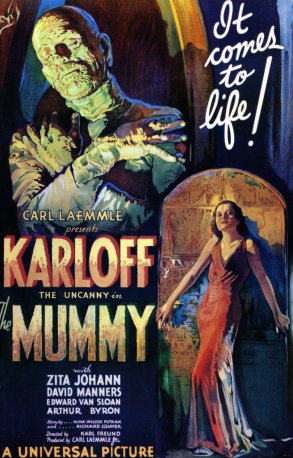The Mummy
Mummy-Mania
The Mummy [ edit ]
In 1922, Howard Carter and Lord Carnarvon brought Tutankhamun to the world and with each treasure that emerged from the dark of the boy king’s eternal resting place Egyptomania intensified to a fever pitch, further fueled by the rumors of “the curse of Tutankhamun”. The 20th century revival of Egyptomania spawned a preoccupation with the subject in popular culture that persists today. In 1932, Carl Laemmle, Jr. of Universal Pictures, riding high on the twin successes of Dracula (1931) and Frankenstein (1931), commissioned an ancient Egyptian themed monster movie. Inspired by the curse of Tutankhamun and drawing on elements of both Bram Stoker’s “Dracula” (1897) and Sir Arthur Conan Doyle’s “The Ring of Thoth” (1890), the tale encapsulates the conflict between the scientific methodology of “Egyptology” versus the romanticism of “Egyptomania”, embodied by two characters. As the movie opens, Sir Joseph Whemple, established Egyptologist and scholar, lectures his impulsive assistant Ralph Norton on the importance of methodically cataloging finds and attention to scientific detail versus the temptation of the newly discovered mummy. It is Egyptomania that wins out; in reading from the scroll of Thoth (here depicted in the hands of Imhotep himself), Ralph Norton reinvigorates the Mummy, who rises to walk the earth again in search of his ancient love. The Mummy epitomizes Egyptomania’s distillation of Egyptian civilization into it’s most lurid elements as viewed through the glass of pseudo-science, hermeticism, and mysticism — the mummy as the cursed undead, an eternal forbidden love, the thrill of archaeological discovery, the mystical powers of ancient texts, reincarnation, and the enduring popularity of the goddess Isis.
Date
1932
Dimensions
27 x 41 in
Artist or Author
Universal Pictures
Material
Paper
Museum
Private Collection
S. Membury, “The Celluloid Archaeologist—an X-rated exposé,” in Russell, M., ed., Digging Holes in Popular Culture: archaeology and science fiction, (= Bournemouth University School of Conservation Sciences, Occasional Paper 7), (Oxford: Oxbow Books, 2002).
J.T. Soister, Of Gods and Monsters: a critical guide to Universal Studios’ science fiction, horror and mystery films, 1929-1939, (Jefferson and London: McFarland & Company, Inc., 1999)
M.A. Vieira, Hollywood Horror: from gothic to cosmic, (New York: Harry N. Abrams, Inc., 2003)






























